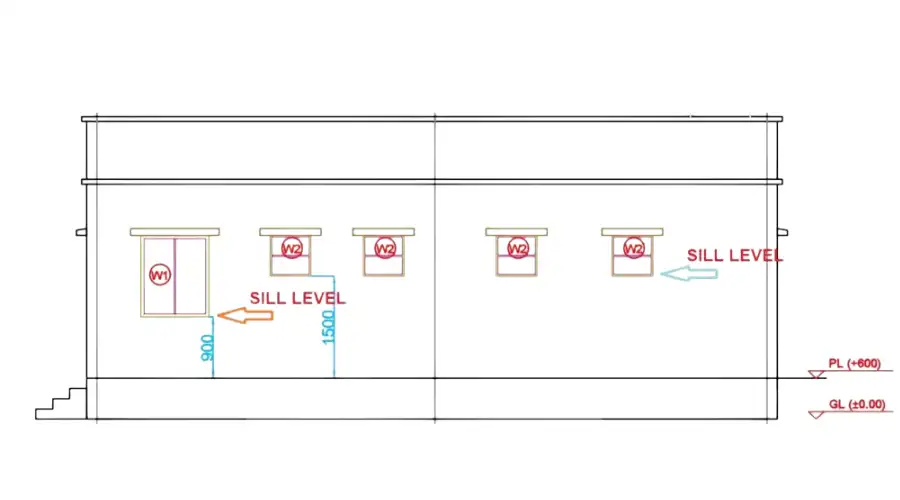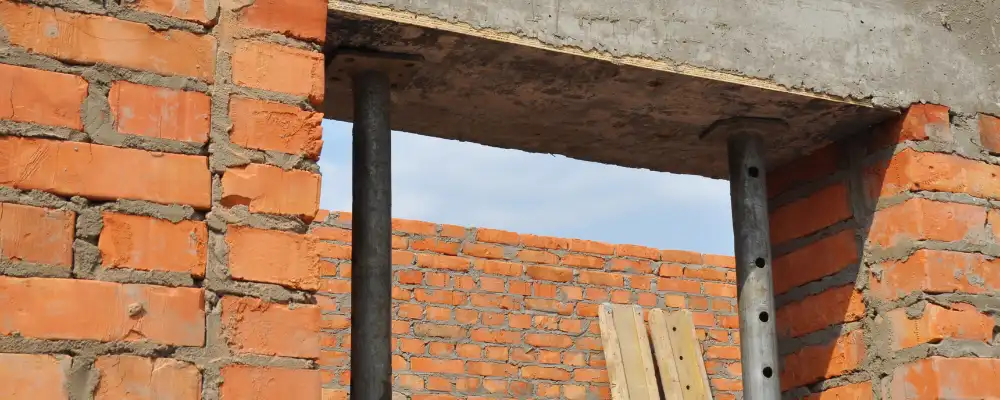In today’s architectural projects, every action taken during construction is crucial for ensuring accuracy. There are different levels in construction called sill and lintel, each of which serves a specific purpose in the construction of doors, windows and other such components. The sill level serves specifically for the construction of windows, preventing overload cracks on the bottom level. Continue reading the article to explore the purpose and importance of sill level in construction.
What is Meant by Sill Level Height?
Window sill height, or simply sill height, represents the vertical distance between the finished floor level and the bottom edge of a window opening. This height plays both aesthetic and functional roles in building plan. Moreover, it influences the entry of natural light and ventilation, and privacy levels.
The standard sill height isn’t fixed. It varies depending on the type of room and its intended use. For instance, private spaces like bathrooms have a higher sill height of approximately 1500 mm to maintain privacy while still allowing light and air to pass through. On the other hand, common areas like living rooms have a lower sill height which is typically around 600mm to 900mm to provide broader exterior views and access to more daylight.
The Importance of Correct Sill Level Heights
As some people think, a sill level isn’t just a random height. It is an accurate measurement used to achieve the following factors.
- Natural Light and Outdoor Views: Sill heights decide how much sunlight enters a room and what you can see outside. To be clear, lower sill heights brighten up spaces and provide better views, whereas higher ones offer more privacy and wall space.
- Proper Air Ventilation: The next crucial importance of a window sill is airflow in a room. Higher sill levels help expel hot air in warm climates. On the other hand, lower sill levels can catch cool breezes.
- Safety Standards: Safety is another important factor of window sill level heights. A home with kids or elderly people must have sill heights that are safe. Having a higher sill reduces any accidental fall risks. Therefore, most building codes have set minimum heights for windows to ensure safety.
- Furniture Arrangement: The sill level also impacts how you place furniture like beds or sofa and the dimensions of these furniture pieces. A well-planned sill height offers flexibility in room layouts without blocking natural light or airflow within the interior space.
Factors Influencing Sill Level Heights
The factors that influence sill level height vary from project to project. Each factor influences the standard dimensions of a window used in a project. These factors include:
- Purpose of the Room: As mentioned earlier, the purpose of a room plays a prominent role in deciding sill level height. It should balance all essential aspects like light, airflow, outside view, privacy, and aesthetic look.
- Climate Conditions: Yes, climate also influences design choices. For rainy areas, a higher sill is good as it can prevent water seepage. In contrast, hot regions must have lower sills to get proper ventilation, but also include additional windows with high sills to remove hot air.
- Building Codes & Safety: No matter what, builders should adhere to local building rules and regulations when determining sill level heights. The respective officials have already set minimum and maximum sill heights for safety and accessibility purposes.
- Architectural Plans: The architectural design of the building also influences sill height preferences. If it is a traditional theme, it may require higher sills whereas modern design can have floor-to-ceiling level windows.
- Interior Layout & Design: The sill height you plan should go well with your interior layout. Make sure windows aren’t blocked by furniture pieces, preventing natural air and light to flow in freely.
- Energy Efficiency: Sill level height can affect the thermal performance of a space. A smart placement results in increased thermal comfort, enhances energy efficiency and reduces energy bills.
Sill Level Heights: Building Codes and Guidelines
Sill level heights differ based on room type, purpose, and overall design. Although there are no set standard heights for sill levels in building codes, some of the standard dimensions commonly maintained are as follows:
- The sill-level height of a living room or bedroom window is between 600mm and 900mm.
- Kitchens: 1050mm – 1200 mm (windows here must be above the kitchen countertop level)
- Bathrooms: 1500 – 2100mm (to provide more privacy)
- Commercial building windows: 900- 1200 mm
How to Measure and Set Sill Level Heights

To measure the sill level height, you will need several tools, including a pencil, chalk, spirit level, marker, and measuring tape. Then, the additional tools are a laser tool for quick measurement, a spirit level for small constructions, and a dumpy level tool, which is required to measure the water level.
- Step 1: Take a tape to measure the sill level. Before that, make sure to determine the finished floor level accurately.
- Step 2: Mark the required sill-level height with the help of a measuring tape. The measuring tape is a reliable tool to get an accurate sill level height in mm or inches.
- Step 3: Make a note of the sill level height in your notepad.
- Step 4: Recheck the measurement, finalise the sill level height, and then begin the working process.
Final Thoughts
The measurement of the sill level height is essential for constructing windows or other openings, as it significantly reduces the likelihood of cracks forming in the walls. If the right sill level height is not maintained, damages like water seepage and insect penetration can occur, making maintenance difficult after the flawed construction.
Therefore, if you’re a civil engineer, ensure you measure the sill level height properly. Take a measuring tape and mark the measured distance to the exact millimeter. This may seem like a minor detail in construction, but has a huge impact on the building’s functionality. So, spend time measuring and implementing the right sill-level height accurately.

